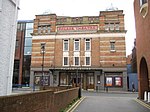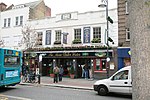Watford High Street railway station
1862 establishments in EnglandDfT Category D stationsFormer London and North Western Railway stationsLondon stations without latest usage statistics 1415London stations without latest usage statistics 1516 ... and 7 more
London stations without latest usage statistics 1617Proposed London Underground stationsRail transport stations in London fare zone 8Railway stations in Great Britain opened in 1862Railway stations in WatfordRailway stations served by London OvergroundUse British English from August 2012

Watford High Street is a railway station in Watford, Hertfordshire, United Kingdom. It is served by the Watford DC line on the London Overground network. It is the only station on the line's sole deviation from the West Coast Main Line.
Excerpt from the Wikipedia article Watford High Street railway station (License: CC BY-SA 3.0, Authors, Images).Watford High Street railway station
Pump House Crescent,
Geographical coordinates (GPS) Address Nearby Places Show on map
Geographical coordinates (GPS)
| Latitude | Longitude |
|---|---|
| N 51.652597 ° | E -0.391812 ° |
Address
Watford High Street
Pump House Crescent
WD17 2AH , Watford Heath
England, United Kingdom
Open on Google Maps








